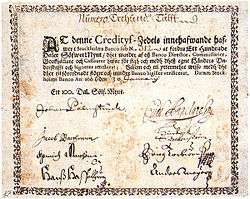Johan Palmstruch
Johan Palmstruch (June 13, 1611 – March 8, 1671) was a Latvian-born Dutch entrepreneur, financier, and financial innovator. He is often credited with the introduction of paper money to Europe. [1]
Biography
Johan (Hans) Wittmacher was born in Riga where his father was a merchant. Sometime in the 1630s, he moved to Amsterdam where he married Margrieta van der Bosch (1617-1677) in February 1644.[2][3]
He became a commissioner in the National Board of Trade after his arrival in Sweden in 1647 and began submitting proposals for banking institutions to King Charles X Gustav in the 1650s. The first two such proposals were rejected but the third, which promised half the bank's profits to the crown, was accepted. He was made a Swedish nobleman under the surname Palmstruch and become a commissioner at the National College of Commerce.

Stockholms Banco was thus founded in Stockholm during 1657 with Palmstruch appointed as bank director and general manager. The bank itself was nothing new as it was simply an imitation of the successful public deposit banks of Amsterdam and Hamburg, however Palmstruch himself added two important innovations.
The first of these was to use money deposited into accounts at the bank to finance loans, however this soon became a problem as the deposits were usually short-term and the loans long-term, meaning that deposited money was unavailable to be withdrawn by account holders. [4]
Palmstruch's second innovation, and his solution to this problem, was the introduction in 1661 of credit paper (Kreditivsedlar), the first European banknotes, which would be exchangeable at any time for the gold and silver coins they were replacing.[5] These were very successful, but the bank began lending more than it could afford and printed too many banknotes without the necessary collateral, leading to the bank's collapse in 1668. This led to the founding of the Sveriges Riksbank. [6] [7]
Palmstruch was charged with irresponsible book-keeping and with not having the cash to repay these credit notes due to miscalculation and omissions in his book-keeping. He was unable to make up this shortage and in 1668 was sentenced to loss of his title, loss of his banking privilege, and eternal exile or death. The government reprieved the death penalty and Palmstruch was instead imprisoned. He remained in prison until 1670 and died the following year at the age of 60. [8]
References
- Sven Fritz. "Johan (Hans) Palmstruch". Svenskt biografiskt lexikon. Retrieved April 1, 2019.
- "Palmstruch (Palmstruck), släkt". Svenskt biografiskt lexikon. Retrieved April 1, 2019.
- DTB Amsterdam City Archives
- "Stockholms Banco 1657-1668". hem.passagen.se. Retrieved April 1, 2019.
- See Palmstruchska banken, Kreditsedel 10 daler silvermynt, 17 april 1666, alvin-record:47808 for a description and an image of such a banknote with Palmstruch's own signature
- Ingrid Van Damme. "The cradle of the European banknote stood in Sweden". Museum of the National Bank of Belgium. Retrieved April 1, 2019.
- "Historisk monetär statistik i Sverige 1668-2008". riksbank.se. Retrieved April 1, 2019.
- Rob Wile (April 8, 2013). "Here's Why The World's First Central Banker Got The Death Penalty". Business Insider. Retrieved April 1, 2019.